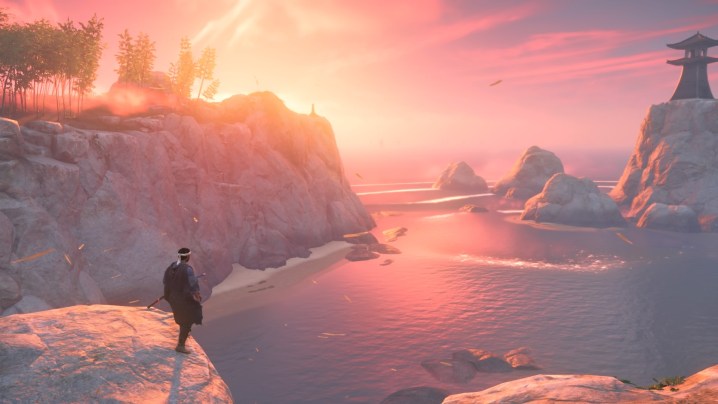Photo modes have become a staple in Sony’s first-party games, and its latest, Ghost of Tsushima, continues that trend. As the PS4’s last major exclusive of any consequence, Ghost of Tsushima is absolutely breathtaking, and its photo mode exemplifies that — allowing you to capture in-game screenshots with tons of customization options at your disposal. But you might be overwhelmed when you jump into its Photo Mode to take some pictures, due to its complexity.
- Basics of Photo Mode
- Use light to your advantage
- Don’t forget to change Jin’s expressions
- You don’t always need to add filters
- Changing the weather makes a world of difference
- Don’t limit your shots to only photos
- The environments are just as pretty as the character models
- …but grabbing those action shots goes a long way
Not to worry, though — we’ve got a handy list of tips and tricks to help when using Ghost of Tsushima‘s robust Photo Mode. In addition to this guide, we’ve also included some beautiful screenshots taken by the community, so we hope you’ll enjoy those, as well.
Further reading:
- Everything we know about Sucker Punch’s Ghost of Tsushima
- Sucker Punch focused on keeping Ghost of Tsushima grounded in reality
- Amazon delays shipments on some Ghost of Tsushima pre-orders
Basics of Photo Mode

Before you get into the nitty-gritty features of Ghost of Tsushima‘s Photo Mode, it’s important to know how to get started. By default, Photo Mode is set to activate when you press right on the D-pad on your Dualshock 4. You can disable this in the options menu. Photo Mode can be accessed pretty much right at the start of the game.
Assuming you’ve left the default settings on, press right on the D-pad and the game will pause, allowing you to manipulate the position of the camera, add filters, change the focal point, and even alter the weather. Keep in mind, Photo Mode can only be activated during gameplay segments, not during cutscenes. When you activate Photo Mode, you’ll come across a slew of options, which might be overwhelming.
The main point is that you don’t need to get lost in all of the features to grab beautiful shots. Simply knowing where to position yourself can do wonders, especially since Sucker Punch did such an exceptional job of making this game beautiful, no matter where your character is. But knowing how to use Photo Mode’s features can greatly enhance the images you take.
From the top, the features are:
- Tracking shot – Quickly toggle between multiple shots.
- Focal length – This lets you zoom in and out.
- Roll – Roll the camera 360 degrees.
- Depth of field – Allows you to alter the overall focus of the shot.
- Focus distance – Use this to change the distance of the subject in focus up to 200 meters.
- Color grading – This serves as the modes list of filters.
- Color grading intensity – Alter the intensity of the filters listed above.
- Exposure bias – You can modify the brightness with this.
- Particles – Gives you 13 different particle options like butterflies, ash, and various leaves.
- Particle intensity – This lets you change the frequency of the particles that appear on screen.
- Wind speed – This lets you alter the intensity of the wind.
- Wind direction – Allows you to alter the wind’s direction in a clockwise motion.
- Clouds – Lets you move the position of the clouds in the sky.
- Time of day – Gives you the option of where to position the sun.
- Weather – Features eight different weather options, some of which include animations.
- Animated environment – Toggles on/off any movement in the shot.
- Jin emotion – Allows you to cycle through 14 different facial expressions.
- Helmet/mask – Activates the ability to see Jin’s face under his headgear.
- Cinema bars – This gives you the bars at the top and bottom of the screen, perfect for a cinematic shot.
- Stamp – Ghost of Tsushima logo will slowly flash on screen.
- Music – Allows you to activate music with nine different options.
When you’re ready to take the picture, make sure you disable the Photo Mode’s UI by pressing the triangle. This will give you a clean-looking image, without a cluttered user interface. To take the snapshot, press the Share button on your controller and it’ll save to your library. You can also capture video this way. Once you’re familiar with the basics of capturing footage, you can experiment with the various features Photo Mode has to offer.
Use light to your advantage



As is true with real-world photography, lighting can make or break your screenshots in Ghost of Tsushima. No matter the shot you’re going for, you should always at least be aware of where the light source is coming from. For those more intense and dramatic shots, you’ll absolutely want to use light to your advantage. Sometimes, it can be as simple as highlighting the subjects of the shot. Other times, that practice can be used in reverse — making the shadows the focal point.
Remember, by changing the time of day, you can alter where the light source (the sun) is positioned, so don’t ignore that feature! Major contrast can really make your images pop. By the same token, use the time of day feature to grab those beautiful night shots, or perhaps you want to show off your new samurai gear during the day. However you do it, make sure you pay attention to the light.
Don’t forget to change Jin’s expressions

Ghost of Tsushima is a game packed with emotion, and you’ll want the main character, Jin Sakai, to match those feelings with his facial expressions. It can really throw off the shot if his face doesn’t match what’s going on in the sequence — for example, if Jin is attacking an enemy, perhaps using the “dead” expression might not be the best.
Switch it to “angry” or “enraged” instead, so it makes sense. Likewise, those intense facial expressions might not match if Jin is simply walking through a field of flowers. Depending on the shot and the lighting, you may not need to worry about this aspect, but for those closeups, it’s essential. Unfortunately, you can’t alter the facial expressions of other characters around you, which is something you’ll want to keep in mind.
You don’t always need to add filters


Luckily, Ghost of Tsushima is absolutely stunning, regardless of whether you manipulate the world in its Photo Mode. It can be tempting to slap a filter on every shot you take, to make things look better, but really, you don’t always need to do this to get a great-looking shot.
By changing the lighting and the position of the shot, you can get gorgeous pictures, with minimal effort. Remember, you can manipulate the lighting by changing the time of day. Try to line up the sun’s position to adhere to the shot you’re going for. The images above all convey tranquility and peace, so making sure they’re bright and clean further conveys the point of the photos.
Changing the weather makes a world of difference


In Ghost of Tsushima, you’ll encounter lots of different weather types, including fog, rain, and snow. All of these weather types can be implemented while grabbing images in Photo Mode. Depending on your shot, you might want to alter the weather to “clear,” which will often give you the clearest image of the overall piece. The first image above was created using the “fog” option, while the second one was captured using “clear.”
You can see a distinct difference in the tones of each photo. One is meant to convey a natural battle scene, while the other is more focused on the contrast and crisp nature of the colors, with an emphasis on tranquility. Using fog or another darker weather type would drastically change the tone of the second image, so keep that in mind when playing with the Photo Mode. By default, the weather is always set to “current.”
Don’t limit your shots to only photos
One of the really neat things about Ghost of Tsushima is that you aren’t just limited to still images within its Photo Mode. You can make short videos or GIFs that are enhanced by keeping its animated environments turned on. In the video above, you can get a sense of the game’s sound effects, lighting, weather, particles, and music all from within the Photo Mode. It’s not the most impressive piece of cinematography ever, but it can still convey what the game has to offer from a purely aesthetic point of view.
You can get really wild with it by enabling intense music, a thunderstorm, lots of wind, and fast-moving particles. On the flip side, you can be much more subtle by turning everything down and simply highlighting the grass slowly swaying in the wind. Whatever the shot is, have fun with it and try to see how intense or subtle you can make it. Remember, you can capture video using the PS4’s internal recording feature.
The environments are just as pretty as the character models



It can be easy to want to focus on Jin in all your shots — and we can’t blame you. The character models in Ghost of Tsushima are impressively well put together. However, it’s important not to ignore the beauty in the game’s environments because they are just as good-looking as the characters themselves. You can get some stunning pictures by focusing on sweeping landscapes, colorful flowers, and the overall beauty in nature.
Your images can look especially captivating if you play with the contrast. Again, manipulating light is key here, but also getting a sense of the color palette you’re working with can impact the overall feeling of the photo. For instance, the first image above is ripe with vibrant colors that are exemplified against Jin’s muted outfit. Don’t forget to soak in the beauty in the world that surrounds you.
…but grabbing those action shots goes a long way



Having said that, Ghost of Tsushima is an action game, after all, so you should always keep your eyes peeled for potential shots during combat. Making use of the black-and-white filters can give your action shots a cinematic feel, especially when combined with the cinema bars. Other shots, like the more gruesome ones above, don’t need as much work to convey the point. However, getting that perfect angle, like the last image above, can go a long way.
While on the lookout for potential images that convey movement, don’t be afraid to experiment with the camera’s position. You might be tempted to simply stay within a few feet radius of your subject matter, but as the final image above shows, camera positioning can really alter the way an image is perceived. The action is mostly the same across a bulk of the images above, but all of them give off their own sense of intensity based on camera positioning, color palette, and emphasis on light and dark.
Editors' Recommendations
- PlayStation trophies are finally coming to PC with new overlay
- Sony’s latest partnership is a big move for PlayStation’s mobile future
- Xbox Series X tips and tricks: how to set up your new console
- Don’t expect a new Sly Cooper or Infamous game anytime soon, says Sucker Punch
- Godfall Ultimate Edition beginner’s guide: 12 tips and tricks to get started




